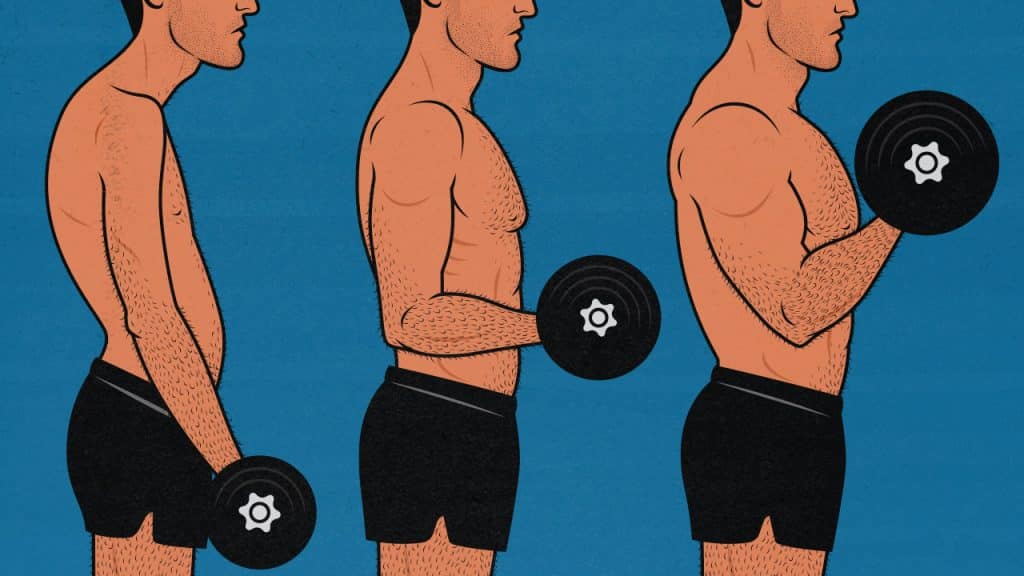
The 3-Day Full-Body Workout Routine for Beginners
3-day full-body workout routines are usually best for beginners. They’re the best for building muscle, gaining strength, getting leaner, mastering your exercise technique, and improving your health.
Once you reach an intermediate level, full-body workouts are still great, but 4-day and 5-day routines start to offer some advantages. That isn’t because 3-day routines become too easy, though. Rather, they get too hard.
In this article, we’ll also give you a workout routine you can follow or build from. It’s designed to get you bigger, stronger, healthier, and better looking. Customize it as much as you want. We’ll show you how.
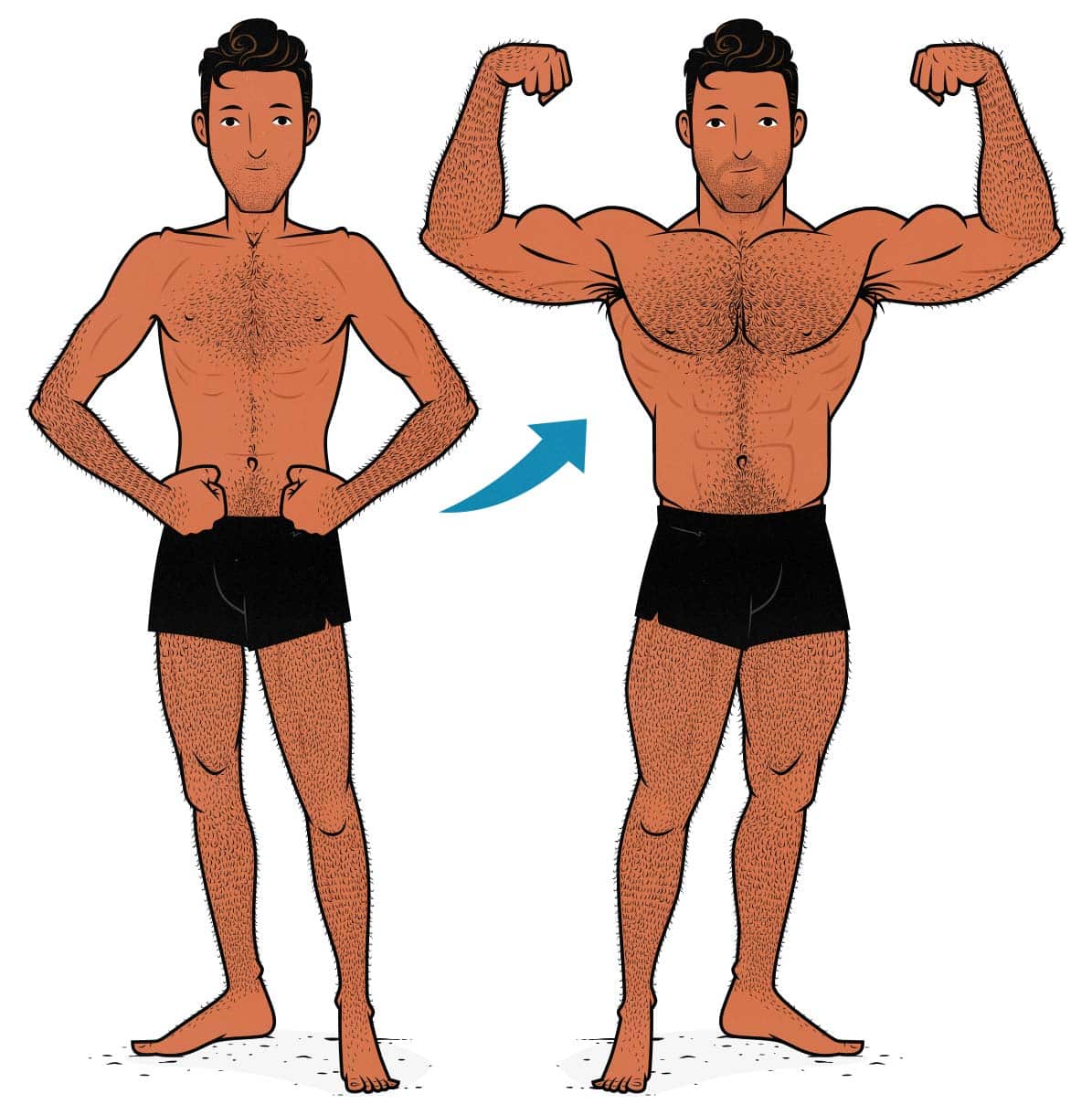
The Basics of Full-Body Workout Routines
Most full-body workout routines have you working out three days per week. Usually, there’s a day or two of rest between each workout, allowing your muscles to at least somewhat recover before you train them again. That gives you a routine that looks something like this:
- Monday: Full-Body Workout
- Tuesday: Rest
- Wednesday: Full-Body Workout
- Thursday: Rest
- Friday: Full-Body Workout
- Saturday: Rest
- Sunday: Rest Again
These are full-body workouts, so you’ll be working most of your muscles every time you work out. If your workout has goblet squats, Romanian deadlifts, push-ups, chin-ups, biceps curls, and triceps extensions, you’ve trained all the biggest muscles in your body. It counts as a full-body workout, even though you haven’t trained your neck or side delts.
Each full-body workout can be different. Typically, you only do 1–2 exercises per muscle group per workout. That means you won’t have the time or energy to do all of the best exercises. You won’t be able to train every muscle, let alone every portion of every muscle. So instead of repeating the same workout three times per week, you can do three different full-body workouts: workouts one, two, and three. That way, you’re able to repeat the big compound lifts 2–3 times per week, and you can include a wider variety of isolation lifts. You’ll build a more balanced physique that way.
It’s good to have two rest days in a row—sometimes. Having two rest days in a row isn’t just an artifact of the seven-day week. It’s also a chance to ditch some of the extra fatigue you’re accumulating. If Friday’s workout is sufficiently challenging, you’ll build muscle all weekend long, so you won’t miss out on anything. The benefit is that you’ll recover more fully. You’ll show up to Monday’s workout feeling stronger and fresher.
The Benefits of Full-Body Workouts
Full-body workout routines are the best default routine for building muscle, especially for beginners. They were the king of the pre-steroid bodybuilding era, championed by ’50s legends like Steve Reeves, who was thought to have the best physique in the world.
They were also popular for developing strength, with the most famous strength coach of the ’70s, Bill Starr, recommending them to everyone who wanted to get strong. Starr’s approach to strength training inspired modern programs like Mark Rippetoe’s Starting Strength and Mehdi’s StrongLifts 5×5, along with countless other variations.
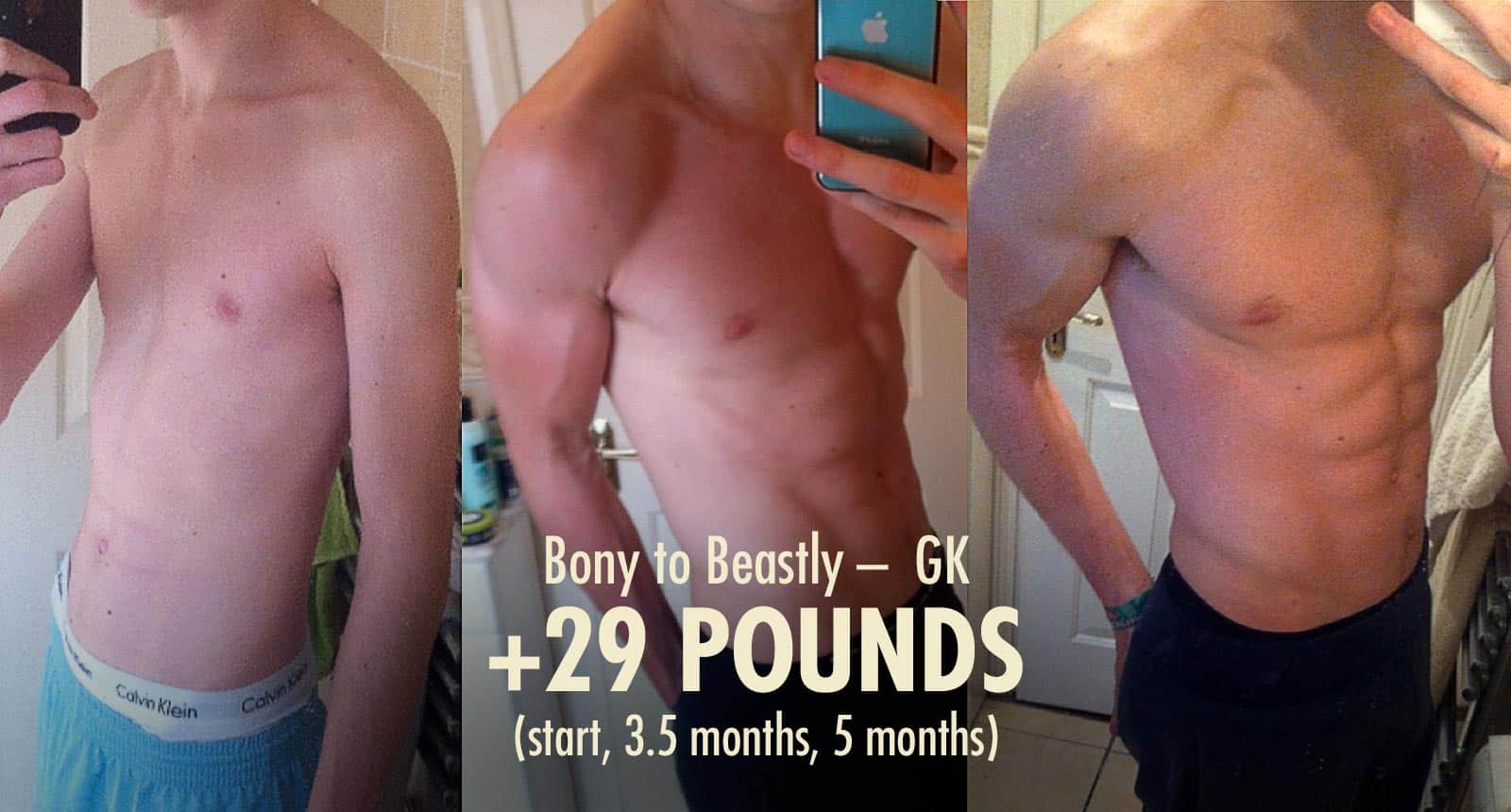
Full-body workouts are lauded for a reason: they work. Muscles grow fastest when you train them 2–4 times per week. 3-day full-body workouts put you in the middle of that ideal range, keeping your muscles growing all week.
Full-body workouts make you a good lifter. They force you to focus on compound lifts, and they give you frequent practice with those lifts, helping you get better faster. Squats are tricky to learn, but if you’re doing them 2 to 3 times per week, you’ll master them in no time. The same is true with push-ups, deadlifts, and chin-ups. (Isolation lifts are much easier to learn. You don’t need to practice them as often.)
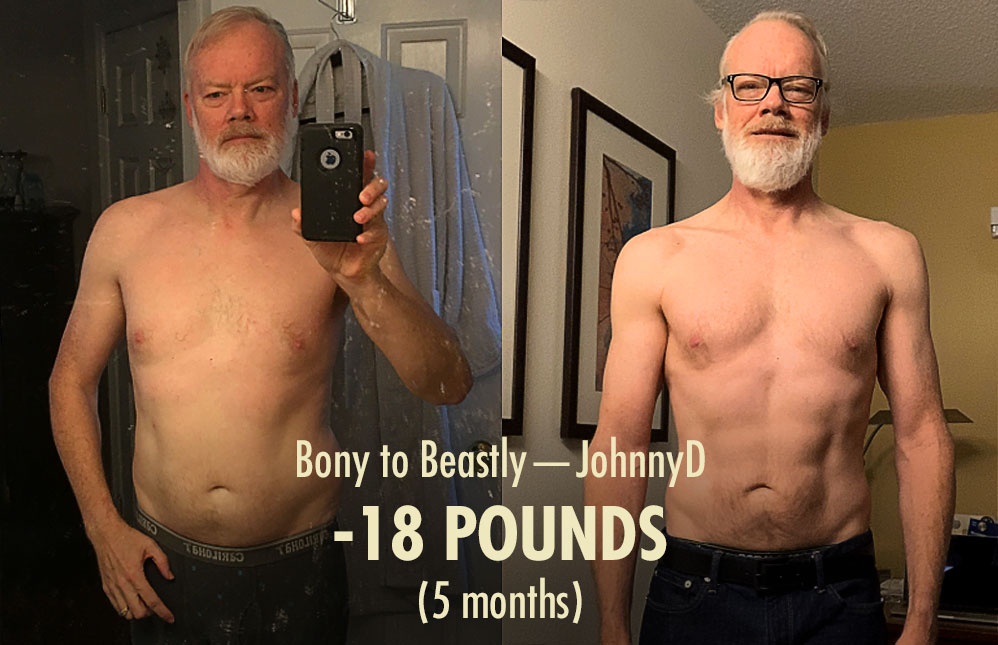
You can superset your exercises, making for incredibly efficient, healthy workouts. When you’re training your entire body all at once, you can pair unrelated exercises together. You can do your push-ups while resting between your sets of deadlifts. You can do your chin-ups while resting between sets of squats. That cuts the length of your workouts in half. It also increases your heart rate, making your workouts better for cardiovascular health.
There are other good ways to train. You could cleave your full-body workouts in half, doing your upper-body lifts one day and your lower-body lifts the next. That will keep your workouts shorter and easier, though it won’t give you as many rest days. Or you could take the opposite approach, doing just two full-body workouts per week, though that won’t be quite as good for building muscle. The point is: there’s more than one way to unskinny a cat. 3-day full-body routines are just the best default.
The Downsides of Full-Body Workouts
There are two major downsides to full-body workouts:
- Full-body workouts can be long. If you’re doing a few sets per exercise and resting a few minutes between each set, it can take you well over 90 minutes just to get through a few exercises. Fortunately, there’s a simple solution: superset your lifts together. 90 minutes becomes 45. Or you could keep your rest times shorter. Or do fewer total sets.
- Full-body workouts can be hard. It’s tough to do squats and deadlifts and push-ups and chin-ups all in one workout. You’re engaging all the biggest muscles in your body, working a tremendous amount of muscle mass. And that’s not even counting the isolation lifts.
Full-body workouts are perfect for novices and intermediates. Newer lifters don’t have as much muscle mass to work, aren’t lifting as much weight, and aren’t as good at grinding through tough reps. This makes full-body workouts much more realistic.
And, as we covered above, full-body workouts are ideal for stimulating muscle growth. If you can do them, you should do them (at least at first). This is especially true if you’re skinny or thin. Full-body workouts will be easy to blast through, and they’ll pack a ton of muscle onto your frame in a hurry.
Full-body workouts get gradually harder. As you keep gaining more muscle, adding more to weight your lifts, and squeezing out more reps, your workouts will get gradually more draining. At a certain point, you might want to split the workload over more training days. You could add a fourth day, then a fifth. Or you could tough it out.
Classic bodybuilders like Steve Reeves stuck with full-body workouts throughout their entire lifting careers. The workouts were long and tiring, but bodybuilders praised vigour back then. As Reeves gained muscle, he improved his vitality a proportionate amount, allowing him to keep up with the ever-increasing workload.
Exercise Selection
For this guide, we assume you want to get bigger, stronger, leaner, healthier, and better looking. And you probably want to maximize your muscle growth rate while minimizing your fat gain rate.
Start with the big compound lifts. Challenge yourself, pushing yourself close to failure. Then add in isolation lifts to bring up the muscles that haven’t been properly stimulated. With these smaller lifts, you can push yourself even harder.
The Main Compound Lifts
Here are the big movements, with a few variations for each. You should include most of these compound lifts in most of your workouts.
- Squats emphasize movement at the knees. They’re designed to bulk up your quads and glutes, the two biggest muscles in your body. These muscles are highly prized by powerlifters and bodybuilders, less so by the general public. But if you’re interested in the health benefits of building muscle, these are the best muscles to train. Plus, front-loaded squats can be quite good for building a thicker back and improving your posture. Goblet squats tend to be the best for beginners. When you’re dominating the largest dumbbells, you can progress to front squats. Back squats are fine, too, though they won’t work your postural muscles as hard.
- Deadlifts emphasize movement at the hips. They’re designed to bulk up your hips, hamstrings, and back. They’re fantastic for improving posture, getting you strong, and making you look strong. Romanian deadlifts tend to be best for beginners, and they remain great forever.
- Presses are from the shoulder joint. They work your chest, shoulders, triceps, and, ideally, your serratus muscles (under your armpits). These are the “aesthetic” muscles. These lifts are extremely popular, and deservedly so. Presses also do a pretty good job of strengthening the postural muscles on the front side of your body. Push-ups tend to be best for beginners. Bench presses and overhead presses are great, too.
- Pulls are also from the shoulder joint. They work the muscles that make up your mid and upper back, such as your lats, rear delts, traps, rhomboids, and rotator cuff. They do a decent job of bulking up your biceps, too. Think of lifts that start with a deep stretch on the back muscles you’re trying to train, such as chin-ups and pulldowns (which stretch the lats), as well as rows and deadlifts (which stretch the traps and rhomboids).
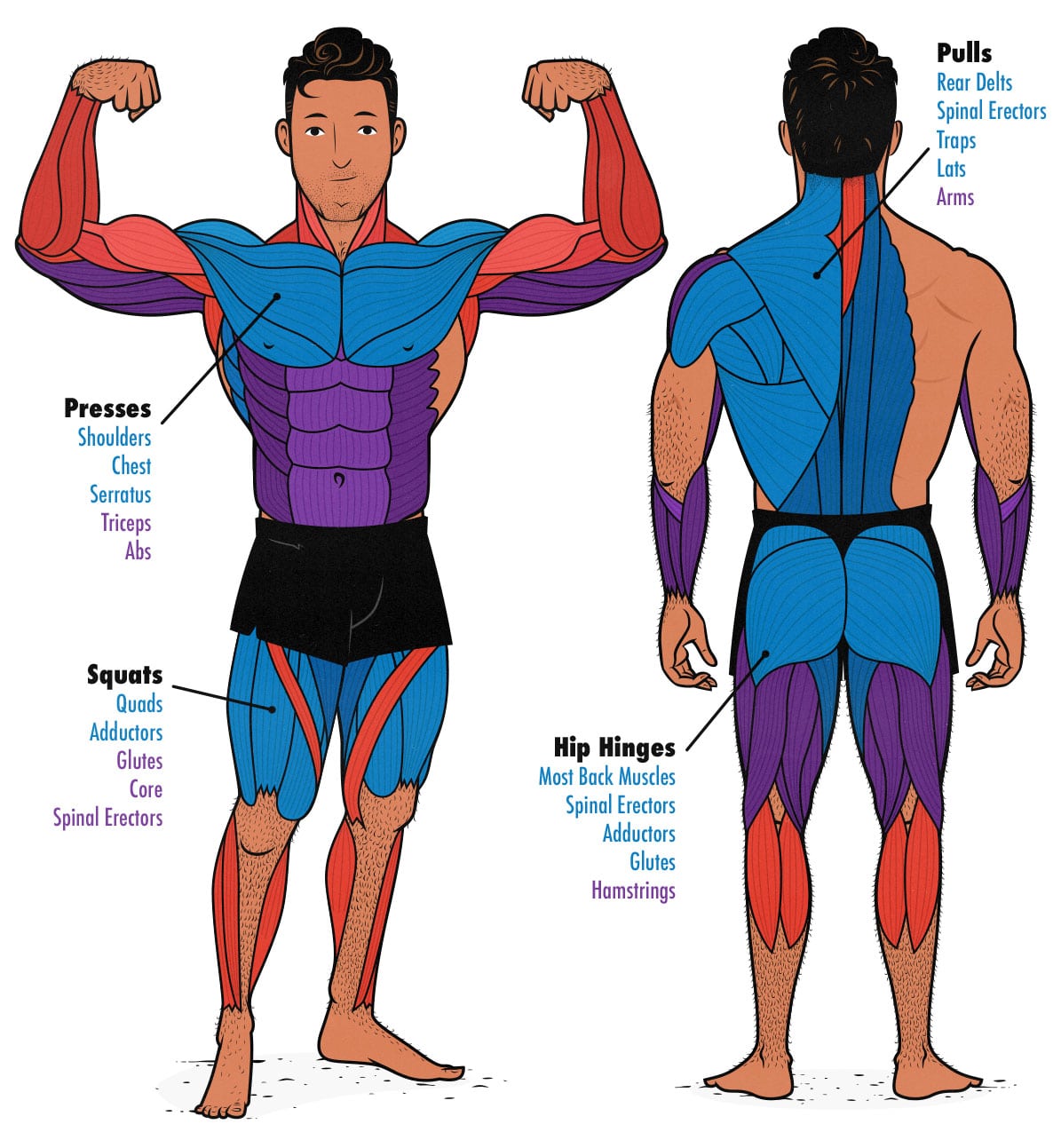
These compound lifts are perfect for every area highlighted in blue. They do an okay job of bulking up the areas highlighted in purple. The red areas won’t grow from that compound lift. For example, presses are ideal for your chest, shoulders, and serratus muscles. They’re okay for your triceps and core. They won’t do anything for your biceps and forearms.
The Main Isolation Lifts
Our bodies are built to do more than just compound lifts. Compound lifts train the most overall muscle mass, but they aren’t ideal for every muscle group. Biceps curls produce twice as much biceps growth as rows (study). Triceps extensions produce twice as much triceps growth as the bench press (study). These studies were done on beginners. And besides, isolation lifts are simple. Perfect for beginners.
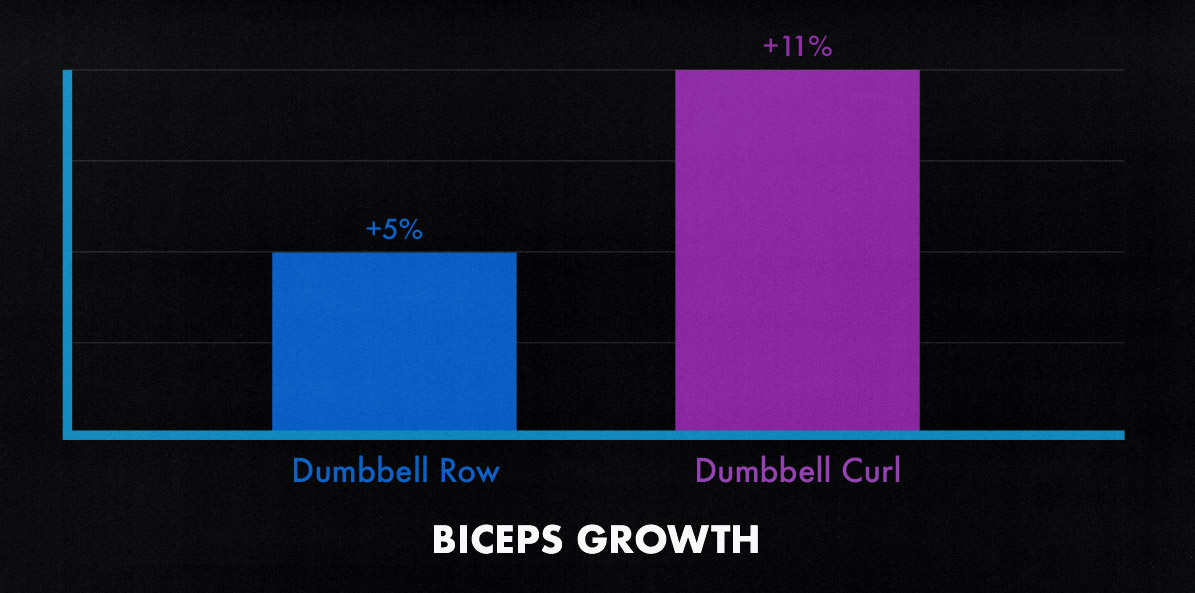
Here are some isolation lifts to consider. All of them train muscles that aren’t properly stimulated by the big compound lifts.
- Biceps curls for your biceps, such as barbell curls, dumbbell curls, cable curls, and incline curls.
- Triceps extensions for your triceps, such as pushdowns, overhead extensions, and skull crushers.
- Side Raises for your side delts.
- Crunches, rollouts, or planks for your abs and obliques.
- Calf raises for your calves (if you want bigger calves).
- Neck curls & extensions for your neck (if you want a bigger neck).
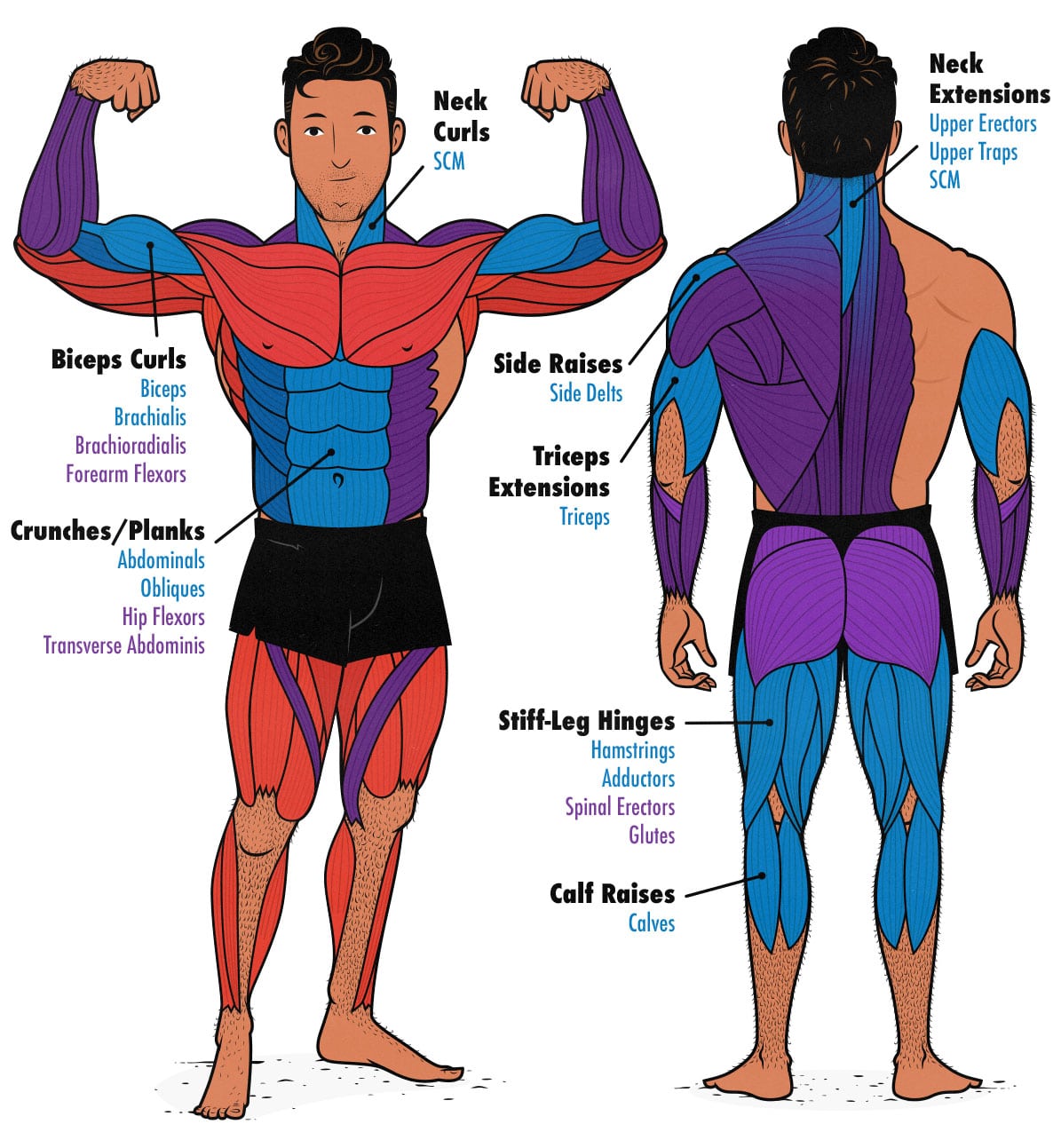
If you look at the illustration, you’ll see that these isolation lifts target all the areas that weren’t being properly stimulated by the compound lifts. Now you’ve got a well-rounded routine. Now you’ll build a balanced physique.
Posture & Technique Exercises
You may also want to include some exercises that help with your posture and lifting technique. You don’t need to do all of these exercises. You don’t need to do them forever. And you don’t need to spend more than five minutes on them every workout. You can do them during warm-ups, rest times, or at the end of your workouts. Once you’re too strong for them, drop them from your routine.
- Planks are a great way of learning how to maintain a good, strong posture under load. They’ll improve your squat, deadlift, overhead press, and push-up technique. They’ll also improve your posture. And they aren’t bad for bulking up your abs, either.
- Side planks develop your postural strength from the side. They’re also one of the few exercises that train your smaller butt muscles—your gluteus medius, gluteus minimus, and tensor fasciae latae (my favourite Starbucks drink). You probably haven’t heard of those muscles, but they’ve heard of you, and strengthening them is great for your hips.
- Loaded carries help develop your postural strength while standing, especially when bearing heavy burdens. They’re also fantastic for your upper traps, which will devour your neck, giving you a more imposing demeanour. Farmer carries are a great type of carry for beginners.
- You may also want to do some external rotation exercises for your rotator cuff. These exercises also do a great job of bulking up your rear delts and some of your upper-back muscles. Face-pulls are popular. We recommend an exercise called TYIs. We’ll teach you how to do them.
Specialization
You don’t have to focus on everything all at once. I recommend doing all the big compound lifts. That way, you develop a good foundation of strength and athleticism. You’ll pack on a ton of muscle, too. With that said, it’s okay to focus on some muscles more than others.
If you’re into sprinting, soccer, or rugby, maybe you put more effort into your lower body. More squats, split squats, and step-ups. If you do martial arts or want to look more attractive, maybe you put more effort into your upper body, doing more pulling and pressing. That’s all totally fine. And besides, you can always change your mind. You could focus on your arms now and your calves later. Or never. Totally up to you.
The Workout Routine
I made a tutorial video walking you through the entire workout routine. I also explain how to lift in a way that maximizes muscle growth.
Each exercise links to a tutorial video on YouTube. Marco will teach you how to do each exercise with a few different pieces of equipment. (Marco has taught thousands of people how to lift weights, including college, professional, and Olympic athletes.)
I made some workout spreadsheets you can fill in. The workout sheets are free to download, and you can keep them forever with no monthly fees. They’re Google Sheets, so you can open them in your browser or download the free Google Sheets app.
get the google spreadsheet of the
free beginner’s full-body workout
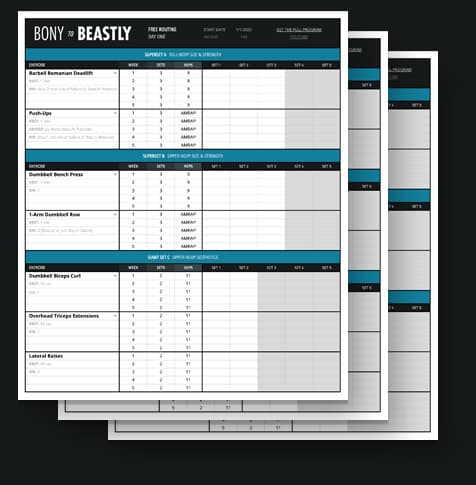
Get the workout as a Google spreadsheet. You’ll be able to pick from exercise alternatives, fill out the sheet, and get our beginner’s warm-up.
Plus, we’ll make sure you’re on the b2B newsletter, and send you all of our best muscle-building content.
By default, we’re assuming you’re training at a commercial gym, but you can do the entire workout routine at home with a barbell home gym or adjustable dumbbells. You can choose dumbbell, barbell, or exercise machine variations using the dropdown menus in the workout sheets. We also teach the dumbbell variations in the exercise tutorial videos.
How to Do the Workout Routine
We recommend supersetting the exercises. Do a set of Romanian deadlifts, rest for a minute, do a set of push-ups, rest for a minute, and then do your second set of Romanian deadlifts. That way, you can keep your workouts short, dense, and intense. You don’t have to superset the exercises, though. If you prefer, you can do them one after the other—”straight sets.” Up to you.
We’ve explained each exercise underneath each superset. That way, you know why you’re doing each exercise. We’ll give you some tips about how long to rest and how hard to push, too.
Every workout, try to add weight or repetitions. This is called progressive overload. When we tell you to do “9 repetitions,” we realize you might get 9 reps in your first set, 8 in your second, and 6 in your third. That’s totally fine. Anywhere from 6–20 reps is great for building muscle. Next workout, try to get 10 reps in your first set, or 9 reps in your second set, or increase the weight a bit. You won’t be able to progress on every exercise every workout, but try your best. Progress drives muscle growth, and muscle growth drives progress. It’s a virtuous circle.
Workout 1
First superset:
- Dumbbell Bench Press: 3×10
- Dumbbell Rows: 3×AMRAP
The dumbbell bench press is another great lift for your chest. It’s a compound lift, but it does a better job of emphasizing the pecs. It’s also great for getting a deep stretch on your pecs at the bottom of the range of motion, which is fantastic for building muscle. Stop a rep or two shy of failure.
Dumbbell rows are great for your lats and upper back, and they’ll bulk up your forearms, too. You can use the same bench and one of the dumbbells you used for the dumbbell bench press. That way, you can superset these exercises together more easily. Do as many reps as possible, going all the way to failure.
Second superset:
- Romanian Deadlifts: 3 sets of 10 repetitions (3×10)
- Push-Ups: 3 sets of as many reps as possible (AMRAP)
All deadlift variations are great for your upper back, spinal erectors, and hips. Romanian deadlifts are the best deadlift variation for beginners. They’re a bit easier to learn than conventional deadlifts, and they put a bit less emphasis on your lower back. They’re also much better for your hamstrings, saving us from needing a hamstring isolation exercise. Stop 2–3 reps shy of failure.
Push-ups are amazing for bulking up your chest, shoulders, and triceps. They’re also great for your abs and serratus muscles (under your armpits). If push-ups are too hard, raise your hands on a bench. Once you can do more than 20, raise your feet up on a bench. Stop 0–1 rep shy of failure.
You can do these exercises as a superset. Do your first set of Romanian deadlifts, rest for a minute, do your first set of push-ups, rest for a minute, and then do your second set of Romanian deadlifts. Keep going until you’ve finished all three sets of each exercise.
The giant set:
- Biceps Curls: 2×12
- Triceps Extensions: 2×12
- Lateral Raises: 2×12
Biceps curls are for your biceps and/or brachialis muscles (which are right underneath your biceps). Triceps extensions are for your triceps. Shoulder raises are for the sides of your shoulders, which will make them broader. Here, we’re doing a giant set of all three arm exercises. Do your biceps curls, rest 20 seconds, do your triceps extensions, rest 20 seconds, and then do your lateral raises. That’s a giant set. Rest another 20 seconds, then do that giant set again. You can take these exercises all the way to failure.
If this workout feels too short or too easy, that’s okay for this week. Next week, you can add extra sets to some of the exercises. If you want to add another exercise to the end, that’s totally fine, too.
Workout 2
The first superset:
- Goblet Squats: 3×10
- Underhand Lat Pulldowns: 3×10
Goblet squats are the best squat variation for beginners, and it’s not even close. Holding the weight in front of you keeps your torso upright, allowing you to sink deeper and giving you a greater stretch on your quads. Holding the dumbbell in front of you also works your upper spinal erectors quite hard, giving you a thicker back and a stronger posture. Stop 1–2 reps shy of failure.
Underhand lat pulldowns are a great exercise for your lats and upper back. The underhand grip will engage your biceps, allowing you to lift more weight and build bigger arms. The main reason we’re using an underhand grip is to build the strength you need to do chin-ups, which are amazing once you can do them. You can take these pulldowns all the way to failure.
You can do these two exercises as a superset. Just carry a dumbbell over to the lat pulldown machine. Rest a minute or so after each set of each exercise.
The second superset:
- 1-Arm Dumbbell Overhead Press: 3×10
- Cable Rows: 3×10
This superset is one of my favourites. The dumbbell overhead press is great for bulking up your shoulders and traps, and doing one arm at a time makes it easier to lift with good posture. Seated cable rows are amazing for your upper back and lats, and they also do a good job of strengthening your spinal erectors, biceps, and forearms.
The giant set:
- Front Planks: 2 sets for 5–10 slow breaths
- Side Planks: 2 sets for 5–10 slow breaths
- Farmer Carries: 2 sets of 40 steps
Planks are great for teaching beginners how to keep a neutral spine while lifting, and they’re pretty good at stimulating your abs and obliques. Challenge yourself, but you don’t need to take your planks all the way to failure. You can think of them more like postural drills than bodybuilding exercises.
Farmer carries are another great exercise for building a stronger posture. They’re also good for building a stronger grip and bulking up your upper traps. Choose a weight that’s excruciatingly difficult to hold by the time you finish your 40 steps.
You can do all three of these exercises as a giant set, resting 20 seconds between each exercise.
Workout 3
The first superset:
- Goblet Squats: 3×10
- Underhand Lat Pulldown: 3×10
You know this superset by now. Rest a minute between each exercise. Remember to outlift yourself. Try adding more weight or getting more reps. Try to stop before failure on your goblet squats, but there’s no harm if you accidentally hit failure while trying to lift more than last time.
The second superset:
- Romanian Deadlifts: 3 sets of 10 repetitions (3×10)
- Push-ups: 3×AMRAP
This is the same superset from the first workout, giving you more practice with Romanian deadlifts and push-ups. This will stimulate muscle growth throughout your entire body, strengthen your postural muscles, and give you a wide chest and a thick back.
The giant set:
- Biceps Curls: 2×12
- Triceps Extensions: 2×12
- Lateral Raises: 2×12
This is a repeat of the giant set from the first workout. The idea is to give your arms and shoulders plenty of stimulation. We want to maximize their rate of muscle growth.
How to Customize The Workout Routine
This workout routine is a great default, but you can change it to suit you better. If an exercise feels bad on your joints or tendons, swap it out for a different one. If a muscle isn’t ever getting sore, find an exercise that works it harder. If you aren’t able to gain strength on a lift, try to figure out whether you’re understimulated (never sore) or over-fatigued (always sore and tired).
If you’re understimulated, add more sets or exercises for that movement pattern. If you’re over-fatigued, consider scaling things back a bit. Maybe that means fewer sets. Maybe it means stopping further away from failure.
It will be easier to gain muscle and strength if you keep your workouts fairly consistent, building momentum as you sink deeper into it. Progressive overload is gradual. If you can, I’d keep your exercise selection and the structure of your workouts fairly similar for at least 4–8 months, making only minor changes every 4–8 weeks.
At the end of that 4–8 month period, evaluate how it went, and figure out what you want to work on next. (Note that if a lift hurts your joints, you should swap that dastard out right away. For example, if barbell curls hurt your elbows, use dumbbells instead.)
Workout Spreadsheets
get the google spreadsheet of the
free beginner’s full-body workout

Get the workout as a Google spreadsheet. You’ll be able to pick from exercise alternatives, fill out the sheet, and get our beginner’s warm-up.
Plus, we’ll make sure you’re on the b2B newsletter, and send you all of our best muscle-building content.
Get Personal Support & Coaching
This article gives you everything you need to start training for muscle growth. Feel free to ask questions in the comments down below. I’ll answer all of them.
If you want us to walk you through a 5-month transformation, we have a full muscle-building program that includes online coaching. We’ll analyze where you’re starting, help you deal with any issues, work around injuries, and give you personal advice. Then we’ll track your progress as you go through the program, ensuring you get the best possible results.
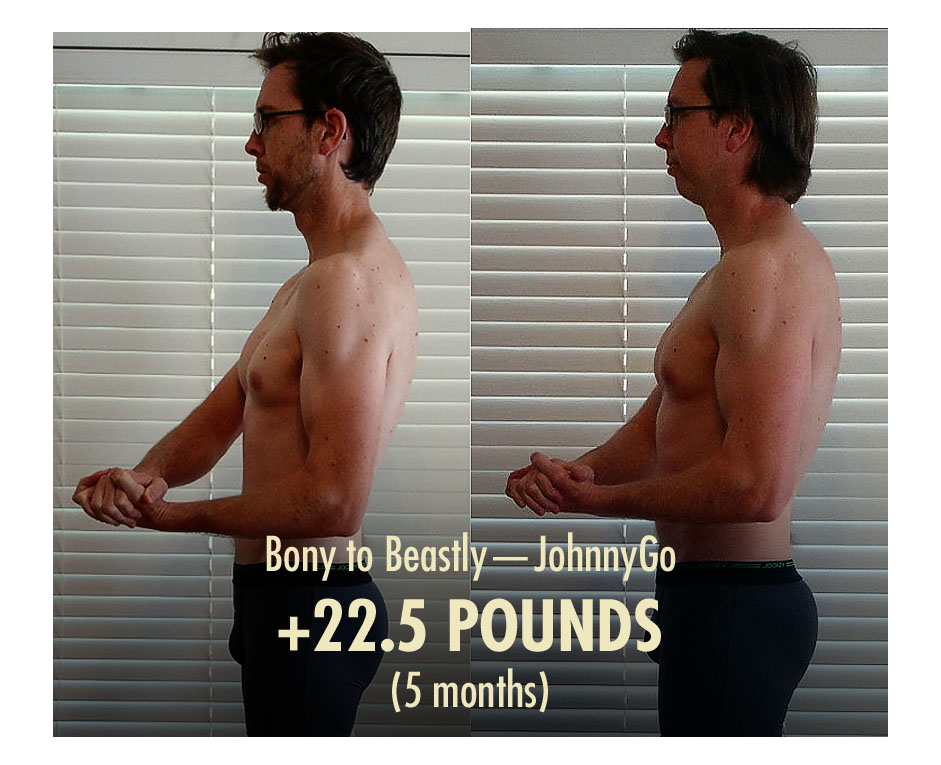
The workouts in our Bony to Beastly Program are similar to these ones, but they’re periodized, meaning we adjust the variables slightly from week to week, and we give you a slightly new workout routine every five weeks. Plus, you can choose your exercises from dropdown menus, and you can track your progress using spreadsheets (if you want). The spreadsheets work perfectly on mobile devices. They’re also totally optional.

The other benefit of the b2B program is all the extra content it includes. It comes with a diet and lifestyle guide, a recipe book full of healthy and convenient bulking recipes, sample meal plans you can get inspiration from (or follow verbatim), and online coaching. We’ll teach you everything you need to know to gain 20 pounds in the next 20 weeks. It comes with a full guarantee, and we have a full refund policy.

